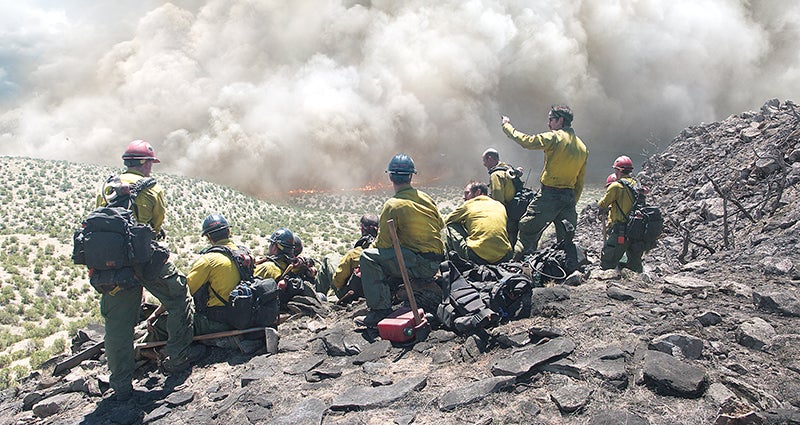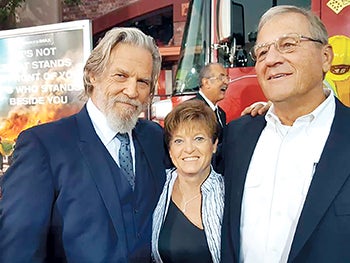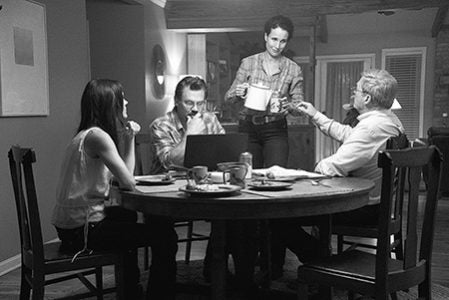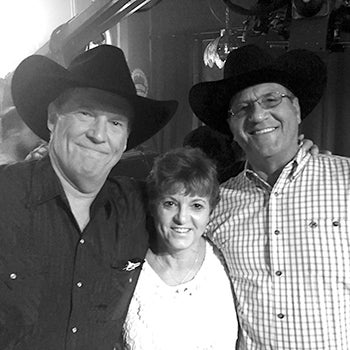Movie bittersweet for Lyle native; Jeff Bridges portrays Duane Steinbrink who helped form the Granite Mountain Hotshots
Published 8:58 am Wednesday, December 6, 2017

- A still from the movie, "Only the Brave," of the Granite Mountain Hotshots crew at a fire scene. Jeff Bridges plays Lyle native Duane Steinbrink, who helped train — and was good friends — with many of the crew. Steinbrink, who lives in Chino Valley, Arizona, also helped to train several of the actors who would play the firefighters in the movie. Photo courtesy of Sony Pictures.
Duane Steinbrink and four alumni from the Granite Mountain Hotshots gathered some 20 actors for a training that would take them hiking up New Mexico mountainsides.
Among the 20 were actors Josh Brolin, Miles Teller, Scott Haze, James Bade Dale and Taylor Kitsch, who would help tell the story of the Hotshots, an elite firefighting team based in Prescott, Arizona, in the film, “Only the Brave.”
The film recounts the lives of the crew and the challenges of the most dangerous kind of firefighting. Nineteen of the 20 crew members died in 2013, fighting the Yarnell Hill Fire northwest of Phoenix.
Steinbrink, a Lyle native, was well-acquainted with the Hotshots. He served as the team’s first wildland division chief who helped to oversee the creation of the group in the 2000’s. He had been retired for three years before the tragic fire, but its impact has remained vivid for the 65-year-old. He is portrayed by actor Jeff Bridges in the film; his wife, Marvel, is portrayed by actress Andie MacDowell.
Steinbrink was also one of the advisers on the film, along with Amanda Marsh, the widow of crew superintendent Eric Marsh, and the crew’s lone survivor of the Yarnell fire, Brendan McDonough. Steinbrink spoke last week to the Herald during a phone interview about the Hotshots and the film from his home in Chino Valley, Arizona. Chino Valley is about 15 miles north of Prescott.
Steinbrink and the Hotshots provided the actors with a week of training to give them a taste of what it meant to be part of the group that some have called the firefighting equivalent of the military’s special forces. Hotshots are firefighters who literally fight fire with fire. They construct back burns and fire lines — literally digging trenches deep enough to a line where nothing will burn. Fire is their foe and their weapon.
“You can’t climb mountains and carry water,” Steinbrink explained.
Steinbrink was determined to give the actors an authentic taste of the job.
“I told them, ‘I don’t care who you are, I don’t care what you’ve done; you’re here representing my friends and you need to give it your all.”

Actor Jeff Bridges, left, with Marvel and Duane Steinbrink at the premiere of the “Only the Brave,” in October in Tempe, Arizona. Bridges portrayed Steinbrink, a Lyle native, who was the wildland fire chief who helped form the Granite Mountain Hotshots. Photo courtesy of Duane Steinbrink.
Hotshots have to be, in a word, tough. They are trained to carry 40-pound packs; they have to hike, run and climb. Candidates for the Granite Mountain Hotshots had to show that they could pass a pack test and complete a series of physical activities, ranging from 40 sit-ups in 60 seconds to seven pull-ups, to a 1.5-mile run in just under 11 minutes. Each in the acting-turned-Hotshot group was outfitted in the right firefighting gear and packs. They hiked rocky ground and slept on it one night.
“They were so committed to doing the right thing,” Steinbrink said. “It was an amazing week.”
He also learned a lot about how actors view their colleagues. Steinbrink took a call from Bridges during the training. Bridges, who could not be there that week, was calling to invite Steinbrink to his Santa Barbara, California, home for two days to go over the script and to make sure the emphasis was right.
“The other actors heard me talking to him on the phone, and they all went, ‘Jeff Bridges? You were talking to Jeff Bridges? Wow,’” Steinbrink said with a chuckle, adding they were as much in awe of Bridges as fans were of them.
It was just one more chapter of a story that has proved as dramatic for filmgoers as it was bittersweet for Steinbrink.
Steinbrink had been a firefighter in Prescott for decades and knew how important it was to have a Hotshot crew — up until the time the Granite Mountain group was formed, the only similar crews were under federal jurisdiction. Prescott’s was the first municipal crew.
A wealth of wildfires in 2000 fanned the need for Hotshot crews.
“In Minnesota, you have tornadoes,” he said. “Here, it’s wildland fires.”
Steinbrink, who moved to Arizona in 1972, retired from the Prescott Fire Department for the first time in 1999 but after about a year, he was approached by Prescott Fire Chief Darrell Willis to see if he would come back to oversee a fuels management crew.
“It was about the time of a lot of fires; Montana was burning up,” he said.
It proved to be the early nucleus of what would eventually become the Granite Mountain Hotshots. A fuels management crew works to create “defensible space” — or rather, eliminate those things that fire wants most to feed on, like brush and vegetation. In doing so, they could successfully slow the progress of the fire, as well as protect property and lives.
The crew worked to clear space within 50 feet of every home; such spaces were built around almost 400 Prescott homes in the first year. In the second, the crew almost doubled that number. The organization morphed into an initial attack crew, widening its work in defensible space in and around Prescott. Finally Crew 7 was certified to become the Granite Mountain Interagency Hotshot Crew, with Steinbrink as its first wildland division chief. “Interagency” meant the crew could travel to other states to provide help. In 2010, Steinbrink said, the Granite Mountain group could be found working in the Boundary Waters Canoe Area in Minnesota.
June 30, 2013, was a Sunday — and, one of the hottest days in Arizona’s history. Steinbrink, by then retired, was in his basement watching television. While switching channels, he heard a news item about the Yarnell fire. There were few details. Steinbrink wasn’t sure what to think.
Yavapai County Sheriff Scott Mascher lived next door.
“I looked across at his house; I saw that his car was gone,” Steinbrink said.
He wasn’t overly worried at that point, but when he got a call from his son-in-law soon after, “I started to get a bad feeling.”
His son-in-law had also heard that the men had been overrun by the fire, but did not know the extent of injuries.
And then Mascher called.
“He said, ‘We have 19 confirmed dead; possibly 20,’” Steinbrink recalled. Steinbrink can remember little else at that moment. Marvel recalled hearing her husband’s first response — a groan.
“I knew so many of them; Eric was a friend,” he said of the crew’s superintendent, Eric Marsh. “I had just talked to him the week before.” He also counted Jesse Steed, Clayton Whitted and Travis Carter among his good friends.
“I just couldn’t believe it. Then my wife said, ‘What about Amanda (Marsh)?’” Faced with having to tell her what he knew, “I remember saying, ‘Oh, man, I don’t know how to deal with this.’”
And then Amanda Marsh called him.
“‘What did you hear?’” she asked.
Although he knew the odds were against Eric being alive, Steinbrink offered no information and told her that he and Marvel were on their way over.
“Amanda met us at the gate, asking what I had heard,” Steinbrink said. “I told her, ‘It doesn’t sound good; it sounds like reality.’”
But he did not elaborate, waiting to get to the Prescott Middle School, where families were asked to gather.
Both Amanda and Steinbrink’s phones kept ringing — dispatchers and fire personnel were contacting him; anxious wives were calling Amanda.
“Marvel finally said, ‘Let’s just turn the phone off for now,’” he said.
The school’s band room was a scene of panic and despair — and questions. All seemed to know there was one survivor, but no one knew who it was.
“It took forever, to find out,” Steinbrink said. In the race to find grief counselors for the families, telling the families who survived and who did not was delayed, creating an emotionally explosive situation.
“‘Is my husband the survivor?’ ‘Is it mine?’” he was asked over and over as women tried to figure out the survivor. “It was just horrible. I kept saying, ‘What is taking so long? They need to know who it is.’”
It was finally reported that McDonough was the lone survivor. He was the look-out for the crew that day, making observations of fire location and weather, and providing the crew with information about how the fire was moving.
It was the perfect storm, it seems, that resulted in the fire that overtook the men.
“Everything lined up for disaster,” Steinbrink said.

Amanda Marsh (Jennifer Connelly), “Supe” Eric Marsh (Josh Brolin), Marvel Steinbrink (Andie MacDowell), Fire Chief Duane Steinbrink (Jeff Bridges) finish dinner in the Marsh home dining room in Columbia Pictures’ ONLY THE BRAVE.
It had already been a hot and dry summer, with temperatures that day reaching over 100 degrees. Winds already over 20 mph kicked up to over 40 mph. Combined with drought conditions, the environs were ready to quickly spread fire begun by a lightning strike on June 28. A thunderstorm created erratic winds. The Hotshots, one of two crews on the scene at Yarnell on June 30, were on their way to a safety zone, but never made it. Some fire shelters had been deployed — and perhaps all, although no one will know, since the fire and winds might have burned them and blown them away before the fire was investigated. In any case, such shelters could not have withstood the sustained firestorm such as the men faced, Steinbrink said. Such shelters are only good for up to 300 degrees; the fires the Hotshots battled would have been over 2,000 degrees.
“They would have died from the heat before the fire ever got to them,” he said.
The Hotshots did their job that day. According to a report prepared by Wildland Fire Associates and presented to the Arizona Division of Occupational Safety and Health, work needed to be done by incident commands on better anticipating conditions and acting faster to bring them out of danger.
But Steinbrink doesn’t like to point fingers. So many factors came into play that day — but one thing he will say. He lost friends that day, who were among the bravest men he knew.
The idea of making a movie about the Hotshots came up almost immediately, he said.
“From Day One, I was taking calls from screenwriters, book authors, movie producers” who wanted his involvement, he said. But three years after the tragedy, “I just couldn’t do it. I just wasn’t ready.”
It was one of the Hotshot widows who helped him change his mind.
“She said, ‘Chief, when this movie producer calls, give him a minute,’” he said.
That producer turned out to be Michael Menchel, and Steinbrink agreed to meet with him over breakfast. He brought Marvel to the meeting as well. Menchel brought director Joe Kosinkski and writer Eric Singer.
“An hour and a half to two hours we sat with them; afterward, we both felt the movie was in the right hands,” Steinbrink said. “The emphasis was put on the men and how they lived, not so much on how they died.”
Having Bridges portray him turned out to be a highlight of the movie process, but not because it was him. They found they shared a love of music, he said.
Steinbrink went to Santa Barbara after Bridges called, who also asked Steinbrink to bring several pieces of his clothing so they could be recreated for the movie.
“I thought, ‘Oh man, he’s an Academy Award winner,’ and then he (Bridges) asked, ‘What kind of jeans are you wearing?’”
Bridges asked because the film would try to recreate Steinbrink’s wardrobe. Steinbrink thought it all a little odd, but he brought two to three boxes of clothes, mostly Wrangler jeans and shirts.
“I told him, ‘I think you can go to a store and get them. He said, ‘But I don’t buy my clothes.’”
The two days were spent going over the script, with Bridges asking him questions about details, what to emphasize, and so on.
But when the men began to play music on their guitars, the bond of music prompted Bridges to ask him to stay two more days. Bridges and Steinbrink both play with country bands and in the movie, Bridges had to recreate Steinbrink’s role in the band “The Rusty Pistols Cowboy Band.” One of the highlights was meeting T Bone Burnett, a famous Nashville producer, who recorded Bridges-as-Steinbrink singing “Ghost Riders in the Sky.” Steinbrink’s fellow band members appeared in the movie with Bridges, leaving the director feeling bad for Steinbrink, whose spot was already filled by Bridges.
So, Steinbrink and Marvel are seen dancing together in one scene; in another scene, Steinbrink and Marvel are seen sitting at a picnic table — right across from Bridges and MacDowell, who portrayed them.
“The production crew said, ‘We have to do this,’” he recalled with a laugh.
Steinbrink and Marvel spent a few weeks on the set. He was proud of the actors, he said, who all spent time with the families of the fallen.
“Each one met with the family of the character they portrayed,” he said. He also praised the work done by Jennifer Connelly, who plays Amanda Marsh, and MacDowell, who played Marvel.
“And Josh Brolin just nailed Eric Marsh,” said Steinbrink. “He did a wonderful job.”

Actor Jeff Bridges with Marvel and Duane Steinbrink on the set of ‘Only the Brave.’ The DVD release is expected in either January or February 2018. Photo courtesy of Duane Steinbrink.
Steinbrink added that the director made sure that each family member knew who their Hotshot was in the film, by hints carried by the actors. For instance, Steinbrink said, if one was a Red Sox fan, you might see his actor as the character wearing a Red Sox hat.
If there was a downside to that time, it was that one of his bandmates, Jim Dunham, died before the premiere in October.
“He was so excited,” Steinbrink said.
Steinbrink attended three screenings of the film; the first was a private showing. He said he sat for several minutes trying to digest what he had seen.
His final vote was that the movie had done its job, and did it well. He is happy it got such good reviews. He feels most of the families felt as he did.
“I thought it brought honor to the crew; honor to all the wildland firefighters,” he said.
Steinbrink doesn’t chase fires anymore. Wildland firefighting “is a young man’s game,” he said. He and some of the families still get together, he said, “some of them, quite often.”
He and Marvel continue to stay in close contact with Amanda Marsh, who started a foundation that helps family members of others who lost loved ones fighting wildfires.
“You work to get through it,” he said, referring to the emotional aftermath of the tragedy.
Today, there are only memories of the brave men who fought as Granite Mountain Hotshots — the city of Prescott never formed another crew. Steinbrink is not sure why that is, but he also knows it would be hard to create another crew with the same expertise, at least initially.
“I am just not sure why; maybe the city did not want to go there (after the tragedy),” he said.
Life goes on.
He plays on a senior softball team, which keeps him busy, he said. The band — which stopped playing for awhile in the wake of Dunham’s death — is reinventing itself as the Rusty Pistols Reloaded. Dunham’s sister, Susie, has joined the group. You can almost hear Steinbrink smile over the phone.
He traveled to Lyle earlier this year and met up with family. His brother, Daryl, is a pastor at an Austin church, and his mom, Betty Steinbrink, lives at The Courtyard in Austin.
“They seemed to love the movie; in fact, my sister said, she had no idea the things I did as a firefighter,” he said.
And, he and Bridges still talk, hoping to play together again. He considers the actor a friend.
And while he’ll never be able to erase the memories of close friends who died fighting fires, he won’t let himself dwell on it.
“It was hard; just awful,” he said of the tragedy, and its aftermath. He said he was familiar with deep loss, having lost a son 20 years ago in a freak accident.
“It is not a club you ever want to be a member of,” he said.
But life is about balance, and you feel that he has his.
“I look at my life, and I am thankful for what I have,” Steinbrink said. “And you’ve got to have faith.”





